Castle of Sigri
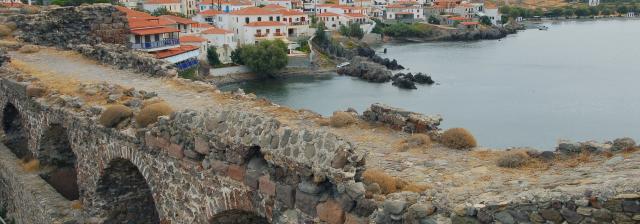
The castle is actually a Turkish fort which was built back in the Ottoman occupation of the island. It's main walls stand proud on the edge of the bay of Sigri and whilst inside there is little to see, it really is worth a visit. the battlements are in tact and you can climb up to the top of them to enjoy the most wonderful views of the village, beach and bay.Sigri Castle was built by the Turks in 1757 in order to protect the port of Sigri (back then the most important port for the transportation trade) from piracy. Throughout the Turkish occupation the castle constituted a central site of the country town, around which the settlement developed in the area protected by the castle.It is of small dimensions, square-like in its ground plan with square towers in its four corners. The central gate in the east closed with a double door covered with iron plates propped up by freckles. It is ornamented with a sharpened point arch -sample of typical Arabic architecture- constructed with alternate red and white stones. In the inner part of the fortress, the arched lintels (built by stones or bricks) of the cells that were used for the accommodation of the permanent guard are of similar inspiration. The castle is open all year and the etrance is free of charge.
Ouzo Museum Barbayannis
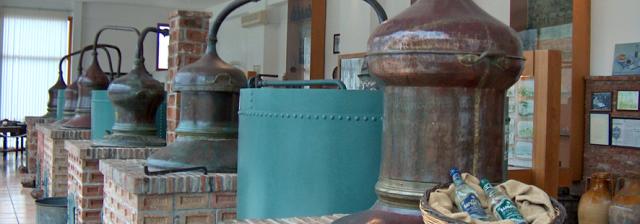
The Ouzo Museum is located next to the modern, privately-owned distilleries of the Barbayannis ouzo production facilities.In the museum visitors can see the original equipment used to bottle and label the famous Ouzo Barbayanni Blue, as well as the first alembic, constructed in 1858 in Constantinople, used for testing century-old secrets and techniques, and to compose the recipes of the Barbayannis family. The Ouzo Museum respectfully embraces tradition and is the home of the secret of the quality and taste found in Ouzo Barbayanni.
Panagia Agiasou
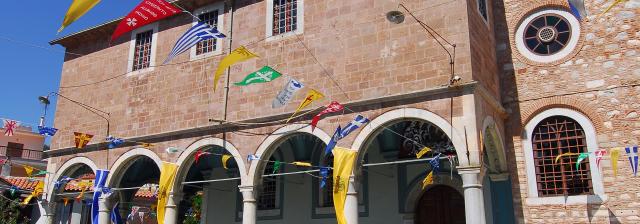
Sultan Mahmud II granted permission for the church to be built as requested by the inhabitants of Agiasos, on condition that the size of the building would not exceed that of the previous one. The church was 32.20 by 26.2 metres (105.6 ft × 86.0 ft). This three-aisle basilica had three apses and three Lord's Tables; the one on the right was dedicated to Saint Charalampus, and the one on the left to Saint Nicholas.
Almost all of the glebes had to be sold in order to finance the reconstruction work of the Church. In 1816 a second fund-raiser was held among the Christians in the towns and villages of Aeolis, in order to finance the completion of the interior decoration work. The construction of the iconostasis, the throne and pulpit by fine craftsmen lasted twenty years.
The church of Panayia is a true palace of faith. The offerings are treasures of priceless worth. Icons from Byzantine and Post-Byzantine era adorning the church, create an impression that one is in a place of divine Byzantine beauty.
The Mytilene Fortress
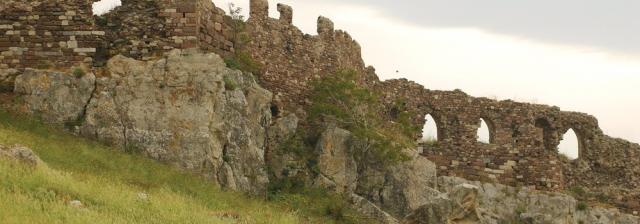
The invitation to a journey back in time inevitably means an exploration of the island’s past through the ruins of the castle and its fortifications. These eloquent monuments tell of the role the fortress has played in the life and protection of the city from the Byzantine era to the present day. The Mytilene fortress stands on a small hill, the highest point on the peninsula, between the city’s northern and southern ports. It was the largest and strongest of its kind in the Eastern Mediterranean. In ancient and Byzantine times, this peninsula was an island, separated from the rest of Lesvos by the Strait of Euripos. The Euripos was located approximately where Ermou Street is today and connected the northern and southern harbors. Silt and human intervention eventually eliminated the strait, transforming the islet into a peninsula.
The Roman Aqueduct at Moria
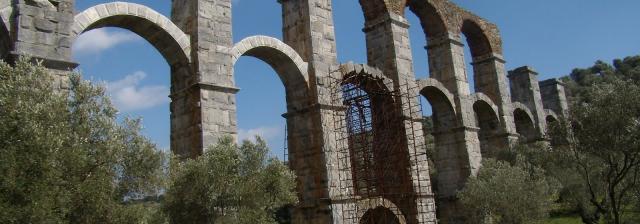
Near the village of Lampou Myloi are the remains of the Aqueduct, a work of superior technical mastery that was built in the 3rd century BC. The Aqueduct ran from Agiassos to Mytilene. Its arcade, stone blocks, piers, abaci and arches that comprised it were made from grey Lesbian marble. In its entirety it resembled the propylaia of a classical temple or palace. It began at the foot of Mt Olympos at Tsingos and traversed 26 kilometers, supplying water to Mytilene by a succession of underground ceramic culverts, channels carved in the cliff-face, and arches. The incline running the entire distance was designed in such a way that the water flowed in unhindered abundance. It was channeled from the Mytilene cistern to the city’s fountains, spas and estates.
Ancient place of Meson
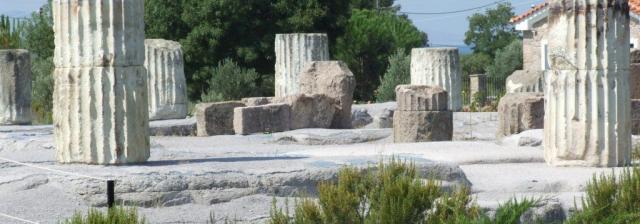
The ancient place of Meson, which was dedicated to Zeus, Dionysus and Hera, was a center of worship and communication and early 4th BC century was the seat of the public lesbian cities.Here were held in honor of Hera, pageant. At the site, visitors can see many architectural members of the church.
Tsarsi Hamam, Geni Tzami
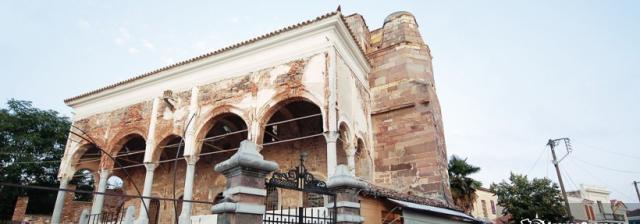
Tsarsi Hamam, Geni Tzami
Continuing north of the city of Mytilene, an alleyway on your left contains the 19th century Tsarsi Hamam. Both these elegant remnants of the Turkish occupation currently function as exhibition spaces.
Towards the end of Ermou Street at the turn off to the fortress is the beautiful mansion that once belonged to the Turkish governor Halim Bei and now houses the Municipal Library.
The Ecclesiastical Byzantine Museum
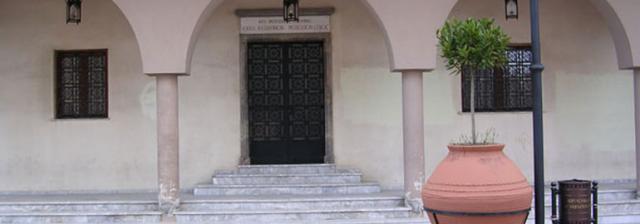
This museum has operated since 1978 in a private building in the center of town, just opposite the entrance to the church of Agios Therapon. Among its exhibits is a collection of portable icons spanning more than seven centuries, the oldest of which date from the 13th century.
The Museum of Modern Art Eleftheriadis Tériade
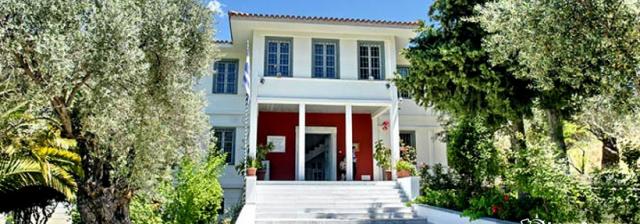
The Museum and Library are housed in the same building as the Theophilos Museum. Sixteen of its 20 rooms display the 29 books by the prominent art critic and publisher Eleftheriadis-Tériade, with illustrations by famous 20th century artists such as Picasso, Chagall, Villon, Leger, Matisse, and others. Each room has a showcase containing one of his books, intact. The surrounding walls display most of the book’s plates and pages, as well as paintings by the renowned Greek painter Yannis Tsarouchis.
Natural History Collection Brisas
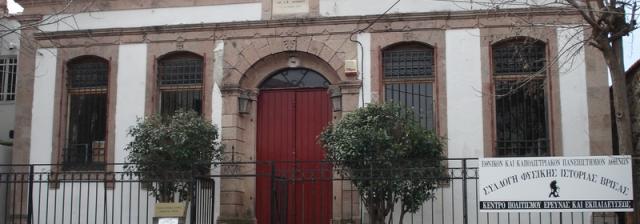
Brisas natural history collection includes fossils of vertebrates and invertebrates found in the area, mineral samples, rocks and ores of Lesvos, Department of Zoology with representative species of the fauna of the island, as well as Department of Botany with contemporary and fossilized specimens of flora in the same region.
Some of these fossils were selected to create the report of fossil vertebrates, which organized so that the visitor can acquire a general impression of the species of animals that lived in the area before 2 million years ago
Georgios Iakovidis Digital Museum
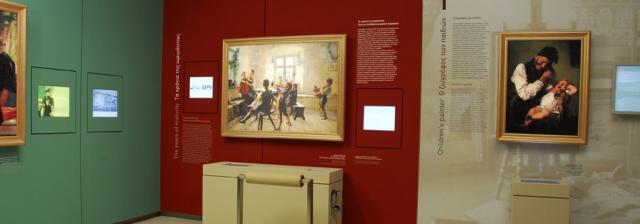
The first difital art museum in Greece, located at Chidira, a mountainous village on th eisland of Lesbos.The Georgios Iakovidis Digital Museum, located at the painter's birthplace, the village of Chidira on the island of Lesbos, is the first fully digital museum of art in Greece. Organized according to a special museological study based on new technologies, it presents the life and work of the renowned Greek painter through a variety of digital means. The Georgios Iakovidis Digital Museum was created on the initiative of the N. G. Papadimitriou Educational and Cultural Foundation. It is intended to function as a meeting place for Technology and Art, offering visitors of all ages a visual experience that combines both pleasure and knowledge.
The Museum of Industrial Olive-Oil Production
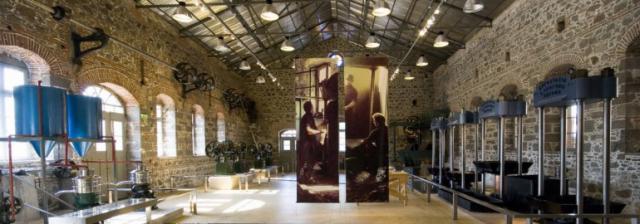
The Museum of Industrial Olive-Oil Production in Lesvos (MBEL) in Agia Paraskevi, on the Island of Lesvos, has been founded and designed by the Piraeus Bank Group Cultural Foundation (PIOP), which is also responsible for its operation. It is housed in the premises of the old communal oil-mill - the Municipality of Agia Paraskevi having ceded their right of use to the Foundation. The project has been included in the 2000-2006 North Aegean Regional Operational Programme and has been financed by the Third EU Structural and Cohesion Fund This Museum is part of the network of thematic museums of technology.
Vareltzidena Mansion
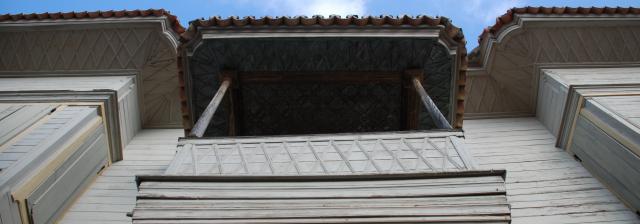
The Vareltzidena Mansion, built in the first half of the 18th century, is located in the centre of the village of Petra. It is a two-floor mansion, resembling a fortress because of the thick stone walls of the ground floor. The mansion combines elements of the local traditional architecture and influences from the Orient and northern Greece. In the past, the ground floor was used as a storeroom, in which olive oil and wine were kept. The first floor consists of a large reception hall, surrounded by six rooms.The walls of the reception hall are decorated with valuable frescoes, typical of the period in which the mansion was built. In one of the rooms the master of the mansion used to invite the elders of the village to discuss public matters.The throne of the master with the family blazon engraved on it still survives. The ceiling of the reception hall is decorated with wood-carvings representing a dove, the symbol of peace.
Sarlitza Pallas
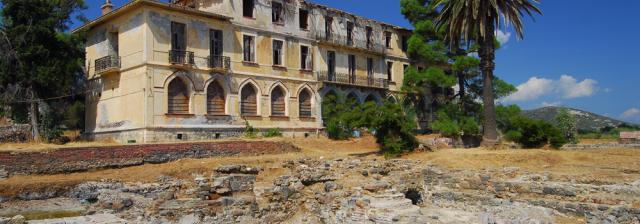
In the early 20th century Thermi was famous for its luxury hotel, the Sarlitza Pallas, which was built in 1909 based on the designs of French architects for Hassan Efendi Mola Mustafa.It passed into the hands of the Greek government and flourished for some 30 years, attracting visitors and famous figures from East and West alike. It began declining in 1933, with the exception of some small glimmers and, stuck in the gears of bureaucracy and indifference, finally succumbed to the ravages of time. Today only the baths are in operation.
Museum - Olive Press Vranas
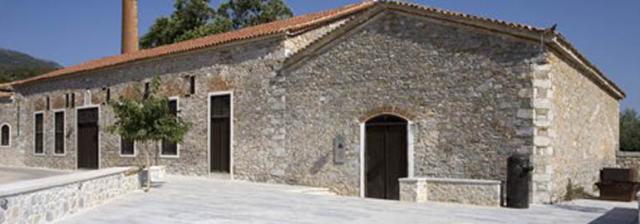
In the village of Pappados, Lesvos, there is the Museum - Olive Press Vranas, established in 1887 by Vranas Nikolaou, which has been bought over by the "Archipelagos" company, restored and it currently operates as a museum of olive oil processing.
The Petrified Forest
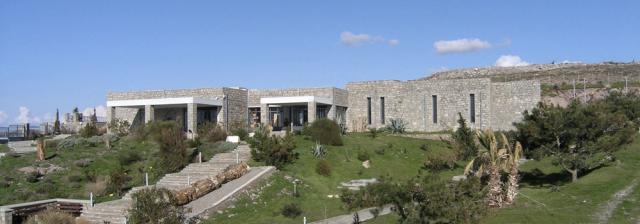
Sigri is famous for its Petrified Forest and for the only Museum of Natural History on the island.
The Petrified Forest is one of the most beautiful monuments of gobal geological heritage. It extends over the northwestern portion of Lesvos, in a region covered almost exclusively by volcanic stone.
The protected area encompasses 150,000 square meters.
The Petrified Forest was created during the intense volcanic activity that occurred throughout the greater northeastern Aegean region 20 million years ago. The volcanic eruptions at that time caused enormous quantities of lava and ash to flow from volcanic vents, covering the center of Lesvos around these vents with molten lava, and the more distant regions with a thick layer of ash.
Abundant petrified tree-trunks in very good condition can be seen submerged in the sea at a depth of 30 meters. The largest concentration of these has been recorded west of the little island of Nisiopi, opposite Sigri. Tree trunks with 2½-meter diameters have been found on the seabed. These finds corroborate the theory of the continuity of the Petrified Forest in this particular underwater region.
In addition to tree trunks, systematic excavations here in recent years have uncovered petrified roots, fruit, branches and leaves.
A Unique Museum of Natural History
The Museum of the Petrified Forest was founded in 1994. Its mission is the research, promotion, display, preservation, protection, and all other suitable exploitation of this unique forest.
Taxiarchis in mantamados
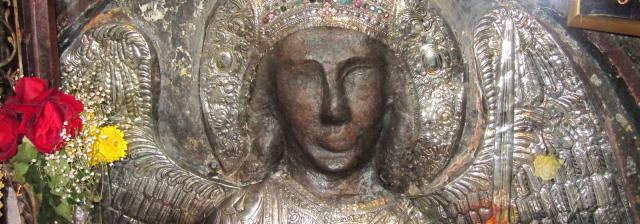
The monastery’s original church was built prior to the 18th century, but was completely reconstructed in 1879. According to legend, the relief icon of the Archangel Michael was moulded from clay and blood. The church contains the prelatic vestment of the martyred Ecumenical Patriarch Gregory V, a national and ecclesiastical relic.
The convent of Saints Raphael, Nicholas and Irene
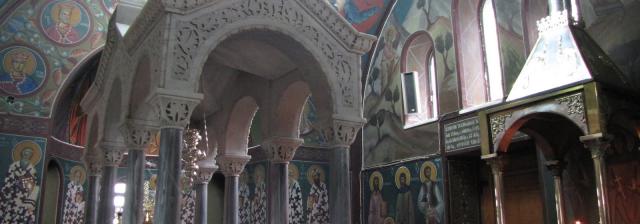
Founded in 1963, the convent was built on the site of a Byzantine monastery that was destroyed by Ottoman soldiers in 1463. It is especially renowned and receives thousands of pilgrims who come to the island solely to visit it and seek the blessing of the Saints. The abbess Eugenia Kleidara, the author of many religious books, and the 40 nuns who comprise the convent’s population are responsible for the convent’s communication and fine reputation.
Pithari Monastery
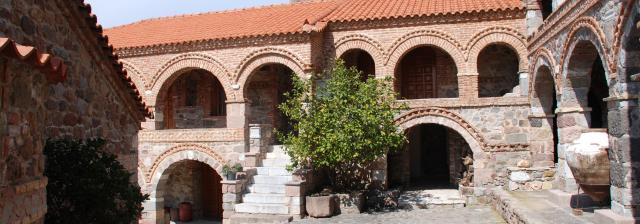
There are two versions regarding the founding of this monastery. According to one, it was a Byzantine monastery that was reestablished during the Ottoman Empire. The other maintains that it was founded in the 16th century.
Moni Leimonos
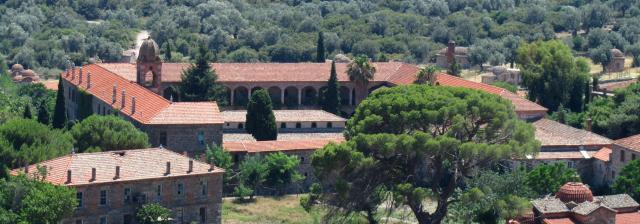
Tall and imposing, the Leimonos Monastery has the most extensive grounds of all the monasteries in Lesvos. It was from its founding year (1526) an important place of asceticism and worship, as well as a dynamic institution of systematized education. Remarkable frescos dating from the 16th and 17th centuries decorate the monastery’s interior.The prominent 16th scholar monk Pachomios Rousanos taught at the renowned Leimoniada School. Its collection of priceless relics and art objects, including Byzantine and Late Byzantine manuscripts and icons, documents, sacred vestments, liturgical vessels, holy relics, and folklore artifacts make this one of the wealthiest monasteries in the Aegean. Its library contains some 5,000 volumes.
Moni Ipsilou
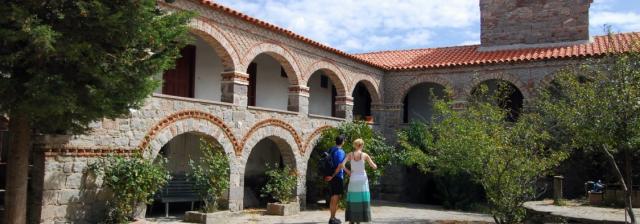
The monastery of Ypsilos, an active men's monastery, is dedicated to St John Theologos and is located in the west part of Lesbos, on the top of Mt Ordymnos, at a height of 634 m and at a distance of 81 km from Mytilene. Tradition places the foundation of the monastery in Byzantine years, before A.D. 800, and mentions it as "Monastery of Korakas", a name which was modified to "Monastery of Zisira" in the years of the Turkish occupation.From its Byzantine phase very little information has been saved and is believed that the monastery was abandoned and devastated in late Byzantine years. The monastery flourishes again in post-Byzantine years but it is destroyed by fire. The existing katholikon (main church) was built in 1832 and constitutes part of a monastic complex, which develops around the katholikon.In the monastery there is a particularly interesting vestry as well as a library with important manuscripts.
Archeological Museum of Mytilene
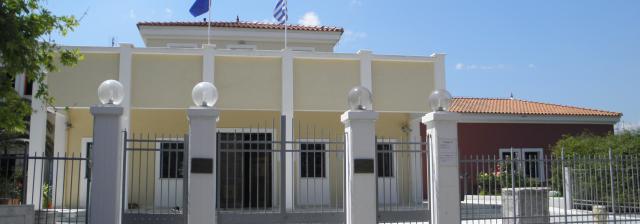
The Archeological Museum is housed in two buildings. The old building is a former mansion and estate. With its lavish carved decoration, the building on its own is characteristic of the early 20th century eclectic architecture in the city. It contains finds from the excavations of the famous prehistoric settlement at Thermi, as well as exceptional column capitals from the island’s celebrated Aeolic temples.The recently constructed modern building conforms to international museological standards. Its exhibits place emphasis on Roman-era Lesvos, and include mosaics, such as those from the famous “Menandros House,” frescos, sculpture, votives, funerary statues and more.
The Theophilos Museum

This museum displays the paintings of the famous local folk artist Theophilos. In operation since 1965, you will find it nestled in a verdant olive grove in the Mytilene suburb of Vareia.
Castle of Molyvos
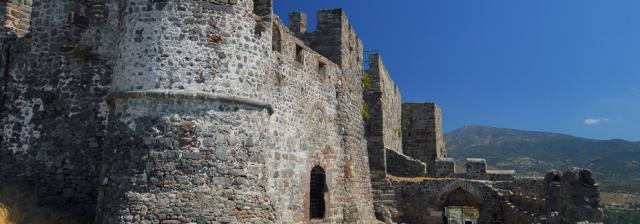
On top of a hill filled with pine trees, above Molyvos village, on the northern side of Lesvos, there is a strong Castle that dominates in the area. The Castle of Molyvos stands as a great historical monument for the whole island and as one of the best preserved castles in Eastern Meditarranean. Open to public, this castle and the castle of Mytilene are the most famous and strongest of Lesvos.The Castle of Molyvos (or Mythimna) was probably constructed in the mid 13th century and it was renovated in 1373 by the Genovese Frangisk I Guateluzo. However, it also went under reformations by the Turks in 1462, so it is evident that the architectural style went under many changes.
Panagia tis Petras
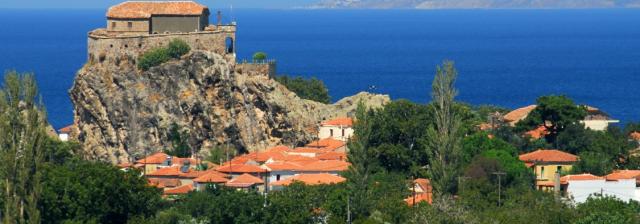
The center of the village is dominated by the rock on top of which is the Church of Panagia tis Glykofilousas (Our Lady of the Sweet Kisses). The rock is enormous, as imposing as those of Meteora in central Greece.At a height of 40 meters, it sprouts out of the tall, slender poplars as though wishing to dominate the level landscape around it. Climb the 114 steps to the top for a breath of Aeolian air and a view of the surrounding hills and blue waters.As prominent as a fortress, the church is a triple-aisled basilica with a narthex, a superb carved wooden bishop’s throne and a well with “holy water.” There are many legends surrounding the finding of the icon of the Virgin and the construction of the church. Ask the locals to tell you about it.
Skala Skamnia
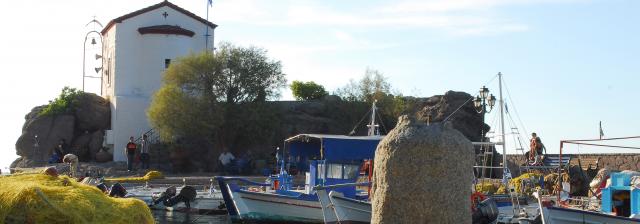
Skala Skamnia is renowned for the little church on the rock that provided the inspiration for the popular book, “Panagia i Gorgona” (“The Mermaid Madonna”), by the beloved Greek writer, Stratos Myrivilis. One of the island’s most developed tourist destinations, Skala Skamnia has plentiful lodgings, excellent seaside tavernas known for their fresh fish, and lovely little beaches, the best being the pebble beach of Kayia. From here you can drive along the coast on a good dirt road all the way to the once-powerful Mithymna, medieval Molyvos.
The Ancient Theatre of Mytilene
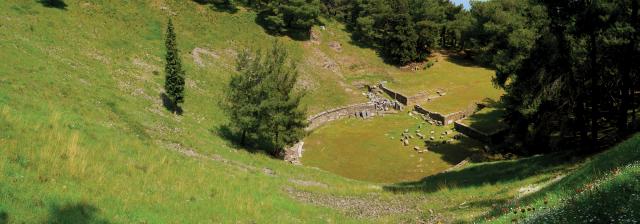
The celebrated Ancient Theatre is situated on the northern hill of the city in a pine-wooded area opposite the fortress, near the old refugee quarter. It was built in Hellenistic times and restored by the Romans. What we see today is the final building phase, which dates from late-Roman times. Excavations carried out in the 1950s unearthed the circular orchestra and the horseshoe-shaped concave seating area, which has been calculated to have held 10,000 spectators. The orchestra is a full circle, with a diameter of approximately 24.20 meters. It is separated from the entirely ruined seating area by a wall, which was tiled in marble, and the skene, which is divided into three corridors.

